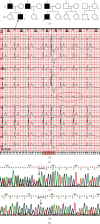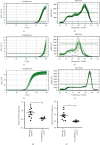Analysis of a Family with Brugada Syndrome and Sudden Cardiac Death Caused by a Novel Mutation of SCN5A
- PMID: 35529058
- PMCID: PMC9072018
- DOI: 10.1155/2022/9716045
Analysis of a Family with Brugada Syndrome and Sudden Cardiac Death Caused by a Novel Mutation of SCN5A
Abstract
Background: Brugada syndrome is a hereditary cardiac disease associated with mutations in ion channel genes. The clinical features include ventricular fibrillation, syncope, and sudden cardiac death. A family with Brugada syndrome with sudden cardiac death was analyzed to locate the associated mutation in the SCN5A gene.
Methods and results: Three generations of a Han Chinese family with Brugada syndrome were recruited in the study; their clinical phenotype data were collected and DNA samples extracted from the peripheral blood. Next-generation sequencing was carried out in the proband, and candidate genes and mutations were screened using the full exon capture technique. The family members who participated in the survey were tested for possible mutations using Sanger sequencing. Six family members were diagnosed with Brugada syndrome, including four asymptomatic patients. A newly discovered heterozygous mutation in the proband was located in exon 25 of SCN5A (NM_000335.5) at c.4313dup(p.Trp1439ValfsTer32). Among the surviving family members, only those with a Brugada wave on their electrocardiogram carried the c.4313dup(p.Trp1439ValfsTer32) variant. Bioinformatics prediction revealed that the frameshift of the c.4313dup (p.Trp1439ValfsTer32) mutant led to a coding change of 32 amino acids, followed by a stop codon, resulting in a truncated protein product.
Conclusion: The newly discovered mutation site c.4313dup(p.Trp1439ValfsTer32) in exon 25 of SCN5A may be the molecular genetic basis of the family with Brugada syndrome.
Copyright © 2022 Yao-Bin Zhu et al.
Conflict of interest statement
The authors declare that there are no conflicts of interest regarding the publication of this paper.
Figures




Similar articles
-
[Novel SCN5A gene mutations associated with Brugada syndrome: V95I, A1649V and delF1617].Zhonghua Xin Xue Guan Bing Za Zhi. 2006 Jul;34(7):616-9. Zhonghua Xin Xue Guan Bing Za Zhi. 2006. PMID: 17081365 Chinese.
-
Novel pore mutation in SCN5A manifests as a spectrum of phenotypes ranging from atrial flutter, conduction disease, and Brugada syndrome to sudden cardiac death.Heart Rhythm. 2004 Nov;1(5):610-5. doi: 10.1016/j.hrthm.2004.07.001. Heart Rhythm. 2004. PMID: 15851228
-
Novel SCN5A mutation (Q55X) associated with age-dependent expression of Brugada syndrome presenting as neurally mediated syncope.Heart Rhythm. 2007 Apr;4(4):516-9. doi: 10.1016/j.hrthm.2006.10.028. Epub 2006 Nov 10. Heart Rhythm. 2007. PMID: 17399644
-
[Doubts of the cardiologist regarding an electrocardiogram presenting QRS V1-V2 complexes with positive terminal wave and ST segment elevation. Consensus Conference promoted by the Italian Cardiology Society].G Ital Cardiol (Rome). 2010 Nov;11(11 Suppl 2):3S-22S. G Ital Cardiol (Rome). 2010. PMID: 21361048 Italian.
-
[Genetic and molecular basis for sodium channel-mediated Brugada syndrome].Arch Cardiol Mex. 2013 Oct-Dec;83(4):295-302. doi: 10.1016/j.acmx.2013.10.001. Epub 2013 Nov 21. Arch Cardiol Mex. 2013. PMID: 24269159 Review. Spanish.
Cited by
-
Twelve-Lead ECG, Holter Monitoring Parameters, and Genetic Testing in Brugada Syndrome: Insights from Analysis of Multigenerational Family with a History of Sudden Cardiac Arrest during Physical Activity.J Clin Med. 2023 Oct 18;12(20):6581. doi: 10.3390/jcm12206581. J Clin Med. 2023. PMID: 37892719 Free PMC article.
-
Unmasking a Silent Killer and Understanding Sudden Cardiac Death in Brugada Syndrome: A Traditional Review.Cureus. 2023 Jun 28;15(6):e41076. doi: 10.7759/cureus.41076. eCollection 2023 Jun. Cureus. 2023. PMID: 37519561 Free PMC article. Review.
References
-
- Brugada P., Brugada J. Right bundle branch block, persistent ST segment elevation and sudden cardiac death: a distinct clinical and electrocardiographic syndrome. A multicenter report. Journal of the American College of Cardiology . 1992;20(6):1391–1396. doi: 10.1016/0735-1097(92)90253-j. - DOI - PubMed
LinkOut - more resources
Full Text Sources
Miscellaneous
